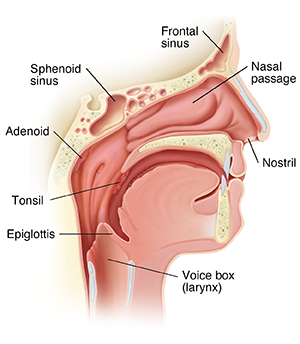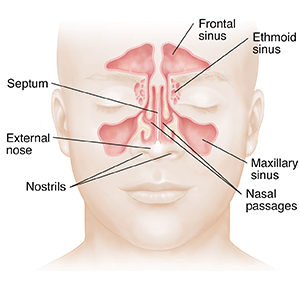Anatomy and Physiology of the Nose and Throat
What is the nose?
Your nose helps you to breathe and to smell. The inner part of the nose is above the roof of the mouth. The nose is made up of:
-
External meatus. Triangular-shaped projection in the center of the face.
-
External nostrils. Two chambers divided by the septum.
-
Septum. Made up mainly of cartilage and bone and covered by mucous membranes. The cartilage also gives shape and support to the outer part of the nose.
-
Nasal passages. Passages that are lined with mucous membranes and tiny hairs (cilia) that help to filter the air.
-
Sinuses. Four pairs of air-filled cavities, also lined with mucous membranes.
 |
| Side view. |
What are sinuses?
The sinuses are cavities, or air-filled pockets, in the skull and face that drain out through the nasal passages. Similar to the nasal passage, the sinuses are lined with mucous membranes. There are 4 different types of sinuses:
-
Ethmoid sinus. This sinus is located inside the face, around the area of the bridge of the nose between the eyes. It is present at birth and continues to grow.
-
Maxillary sinus. This sinus is located inside the face, around the area of the cheeks. It is also present at birth and continues to grow.
-
Frontal sinus. This sinus is located inside the face, in the area of the forehead. It does not develop until around 7 years of age.
-
Sphenoid sinus. This sinus is located deep in the face, behind the nose. It does not typically develop until the teen years.

What is the throat?
The throat is a ring-like muscular tube. It is the passageway for air, food, and liquid. It also helps in forming speech. The throat is made up of:
-
Tonsils and adenoids. Both are made up of lymph tissue and are located at the back of the throat. The adenoids are located all the way at the back of the nose at the very top of the throat. Adenoids shrink away by early adulthood. The tonsils are in the back of the mouth on either side of the throat. They protect against infection but have minimal function after childhood.
-
Voice box (larynx). The larynx is a cylindrical grouping of cartilage, muscles, and soft tissue that contains the vocal cords. The vocal cords are the upper opening into the windpipe (trachea), the passageway to the lungs.
-
Epiglottis. A flap of soft tissue located just above the vocal cords. The epiglottis folds down over the vocal cords to prevent food and irritants from entering the lungs.
Online Medical Reviewer:
Dan Brennan MD
Online Medical Reviewer:
Raymond Kent Turley BSN MSN RN
Online Medical Reviewer:
Sumana Jothi MD
Date Last Reviewed:
9/1/2023
© 2000-2025 The StayWell Company, LLC. All rights reserved. This information is not intended as a substitute for professional medical care. Always follow your healthcare professional's instructions.